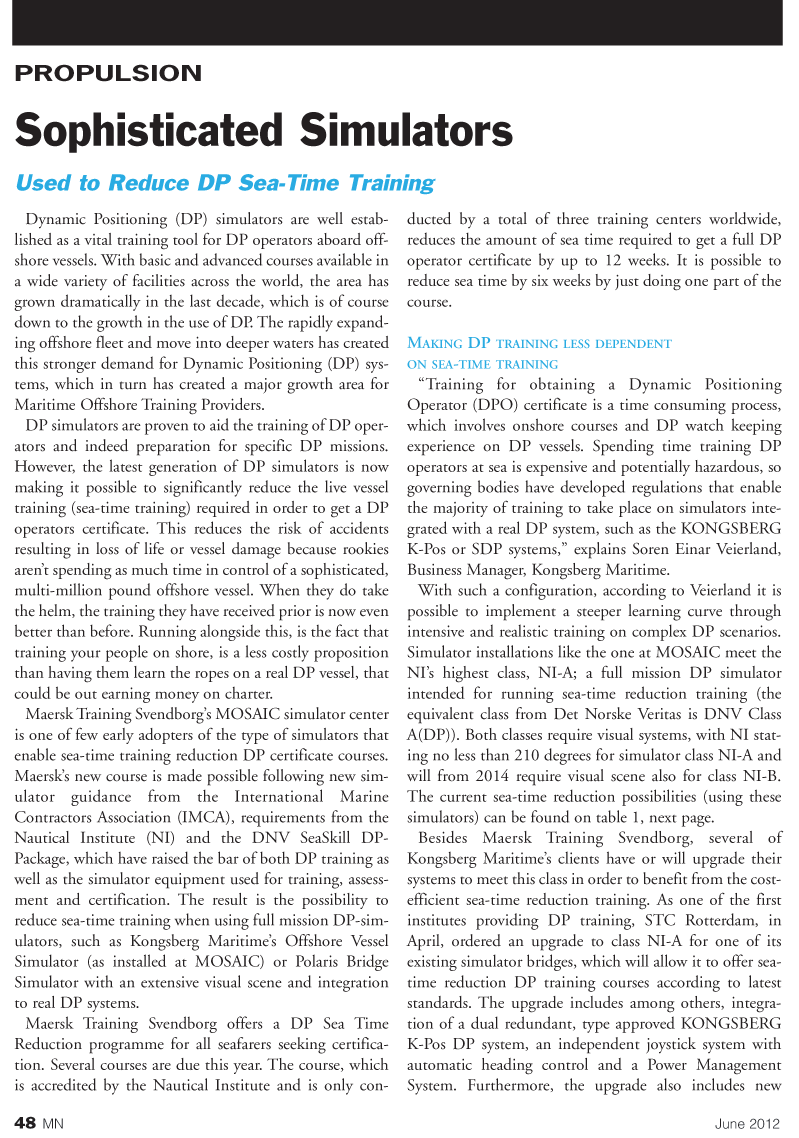
Page 48: of Marine News Magazine (June 2012)
Dredging & Marine Construction
Read this page in Pdf, Flash or Html5 edition of June 2012 Marine News Magazine
48MNJune 2012PROPULSIONDynamic Positioning (DP) simulators are well estab- lished as a vital training tool for DP operators aboard off- shore vessels. With basic and advanced courses available in a wide variety of facilities across the world, the area has grown dramatically in the last decade, which is of course down to the growth in the use of DP. The rapidly expand- ing offshore fleet and move into deeper waters has created this stronger demand for Dynamic Positioning (DP) sys- tems, which in turn has created a major growth area for Maritime Offshore Training Providers. DP simulators are proven to aid the training of DP oper- ators and indeed preparation for specific DP missions. However, the latest generation of DP simulators is now making it possible to significantly reduce the live vessel training (sea-time training) required in order to get a DP operators certificate. This reduces the risk of accidents resulting in loss of life or vessel damage because rookies arent spending as much time in control of a sophisticated, multi-million pound offshore vessel. When they do take the helm, the training they have received prior is now even better than before. Running alongside this, is the fact that training your people on shore, is a less costly proposition than having them learn the ropes on a real DP vessel, that could be out earning money on charter. Maersk Training Svendborgs MOSAIC simulator center is one of few early adopters of the type of simulators that enable sea-time training reduction DP certificate courses. Maersks new course is made possible following new sim- ulator guidance from the International Marine Contractors Association (IMCA), requirements from the Nautical Institute (NI) and the DNV SeaSkill DP- Package, which have raised the bar of both DP training as well as the simulator equipment used for training, assess- ment and certification. The result is the possibility to reduce sea-time training when using full mission DP-sim- ulators, such as Kongsberg Maritimes Offshore Vessel Simulator (as installed at MOSAIC) or Polaris Bridge Simulator with an extensive visual scene and integration to real DP systems. Maersk Training Svendborg offers a DP Sea Time Reduction programme for all seafarers seeking certifica- tion. Several courses are due this year. The course, which is accredited by the Nautical Institute and is only con- ducted by a total of three training centers worldwide, reduces the amount of sea time required to get a full DP operator certificate by up to 12 weeks. It is possible to reduce sea time by six weeks by just doing one part of the course. MAKINGDP TRAININGLESSDEPENDENT ONSEA -TIMETRAINING Training for obtaining a Dynamic Positioning Operator (DPO) certificate is a time consuming process, which involves onshore courses and DP watch keeping experience on DP vessels. Spending time training DP operators at sea is expensive and potentially hazardous, so governing bodies have developed regulations that enable the majority of training to take place on simulators inte-grated with a real DP system, such as the KONGSBERG K-Pos or SDP systems,? explains Soren Einar Veierland, Business Manager, Kongsberg Maritime. With such a configuration, according to Veierland it is possible to implement a steeper learning curve through intensive and realistic training on complex DP scenarios. Simulator installations like the one at MOSAIC meet the NIs highest class, NI-A; a full mission DP simulator intended for running sea-time reduction training (the equivalent class from Det Norske Veritas is DNV Class A(DP)). Both classes require visual systems, with NI stat- ing no less than 210 degrees for simulator class NI-A and will from 2014 require visual scene also for class NI-B. The current sea-time reduction possibilities (using these simulators) can be found on table 1, next page. Besides Maersk Training Svendborg, several of Kongsberg Maritimes clients have or will upgrade their systems to meet this class in order to benefit from the cost- efficient sea-time reduction training. As one of the first institutes providing DP training, STC Rotterdam, in April, ordered an upgrade to class NI-A for one of its existing simulator bridges, which will allow it to offer sea- time reduction DP training courses according to latest standards. The upgrade includes among others, integra- tion of a dual redundant, type approved KONGSBERG K-Pos DP system, an independent joystick system with automatic heading control and a Power Management System. Furthermore, the upgrade also includes new Sophisticated SimulatorsUsed to Reduce DP Sea-Time Training

 47
47

 49
49
